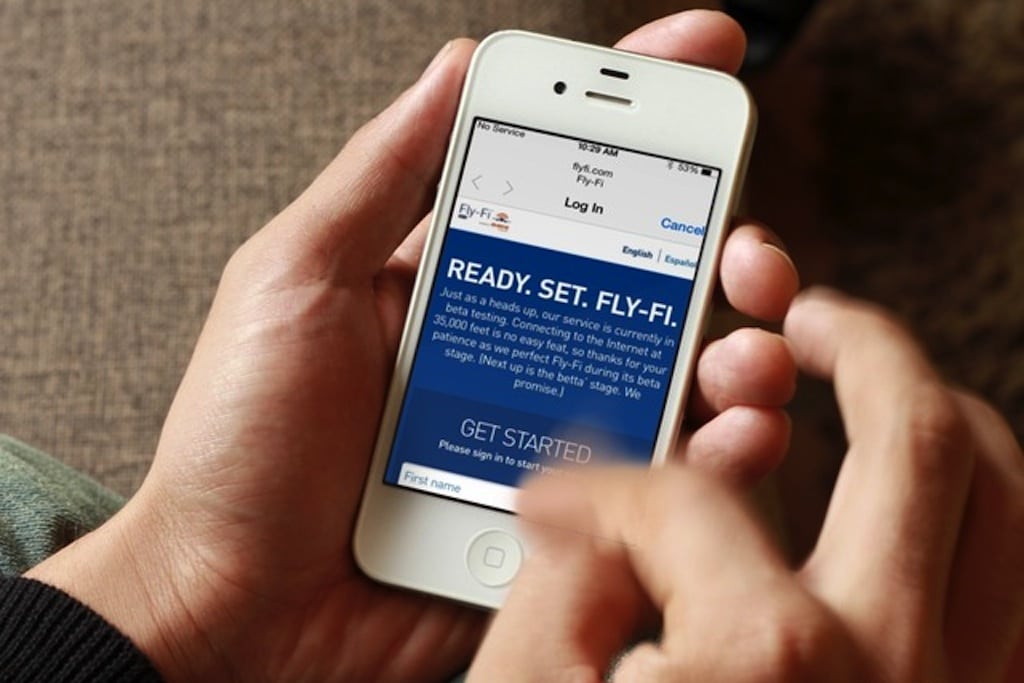Skift Take
These are the opinions of one executive at one of several in-flight Wi-Fi providers that would gain great profits from expanded in-flight connectivity. We can't take his goals as gospel, but it's a vision that all flyers would like to see actualize.
Free and seamless in-flight Wi-Fi is the future of in-flight entertainment, suggests Don Buchman, director of mobile broadband at Wi-Fi service provider ViaSat.
At the launch event for JetBlue’s ViaSat-powered in-flight Wi-Fi, Skift asked Buchman where he saw the service heading over the next few years as airlines invest in faster services and flyers come to expect connectivity.
“Our vision is that you walk out with your device like that and you walk on [to the plane] and you don’t even know that you’re connected to the Internet. You just are. It’ll pick up the Fly-Fi signal and if you’re a repeat flyer, it’ll automatically connect,” says Buchman.
“And then basically, all of a sudden, you’ll get a Facebook update or a Skype or you’ll get an email. You won’t even realize that you were not connected, that you’re in an airplane, that you went 3G to the airplane’s Wi-Fi. That’s the vision, to have a continuous experience.”
When asked if the log-in screen would disappear, Buchman replied, “Eventually, that’d be our goal. The portal is a necessary component today, but we’re hoping to work towards not having to have a portal anymore. Just make it come on. But the portal works today, it allows you to get the premium access as well.”
The Benefits of Being Free
Airlines heavily investing in in-flight Wi-Fi are finding very low engagement among customers, primarily due to the Wi-Fi’s price point. JetBlue‘s new Wi-Fi service will be free for at least the first six months, but Southwest charges $8 a day per device via Row44 and American charges $12 for two hours of connectivity on international flights via Panasonic.
Buchman suggests it’s only a matter of time before the in-flight Wi-Fi business model evolves so that all flyers can access working Wi-Fi for free.
“We think that’s the way it’s going to go,” Buchman says. “If you look at today’s service, all of the airlines are putting on very expensive equipment and only six percent of their customers are using it. That’s very low penetration. If you were an international airline and you put seat-back [screens] in and only six percent of the people actually engaged, you’d think that’s a pretty poor investment. And you probably wouldn’t make that investment.”
“What’s proven, is the only way to really get that high engagement is to offer it for free. So the business models will evolve. Gogo and others have tried free and they got really good engagement, but the service broke down. There wasn’t enough bandwidth to support it. The key to free is having enough bandwidth…no one’s competing and no one’s having a bad experience. Then you have more business models come on, maybe advertisers are willing to sponsor it. If 90 people on a plane are having a good experience then it’s good for advertisers.”
The Daily Newsletter
Our daily coverage of the global travel industry. Written by editors and analysts from across Skift’s brands.
Have a confidential tip for Skift? Get in touch
Tags: in-flight, mobile, viasat, wi-fi
Photo credit: The sign-in screen for JetBlue's new Fly-Fi service could soon be a thing of the past, says ViaSat director of mobile broadband Dom Buchman. PlaceIt.net
